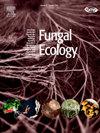龙心菌次生代谢物及其对共生相互作用的影响
IF 2.2
3区 环境科学与生态学
Q3 ECOLOGY
引用次数: 0
摘要
凤仙花真菌寄生在死树上,为凤仙花甲虫提供营养。这种共生关系的一个关键方面是真菌在甲虫隧道周围的木材中定居和支配的能力。这些动态的假设包括主动甲虫管理,真菌接种优先权和真菌的化学生态学。ambrosia真菌产生的化感物质的生态作用尚不清楚。本研究报道了一种分析eupagioceri(子囊菌门:下creales)次生代谢物的方法。鉴定出8种细胞外化合物:5-羟基甲基-2-呋喃羧酸、几种羟基苯甲酸衍生物、4-羟基苯基乙酸(4-HPA)、4-HPA甲酯、酪醇和胸腺嘧啶。大多数化合物表现出跨分类群的活性,抑制细菌、真菌、线虫和螨的生长。我们还指出,这些化合物也有可能通过协同作用调节其生产者甲虫宿主和相关微生物的生理。本文章由计算机程序翻译,如有差异,请以英文原文为准。
Secondary metabolites and their impact on symbiotic interactions in the ambrosia fungus Geosmithia eupagioceri
Ambrosia fungi colonize dead trees, providing nutrition for ambrosia beetles. A key aspect of this symbiosis is the ability of fungi to colonize and dominate the wood around the beetle tunnels. Hypotheses for these dynamics include active beetle management, fungal inoculation priority, and the chemical ecology of the fungus. The ecological role of allelochemicals produced by ambrosia fungi is unknown. This study presents an analysis of secondary metabolites from Geosmithia eupagioceri (Ascomycota: Hypocreales). Eight extracellular compounds were identified: 5-hydroxymethyl-2-furancarboxylic acid, several hydroxybenzoic acid derivatives, 4-hydroxyphenylacetic acid (4-HPA), 4-HPA methyl ester, tyrosol, and thymine. Most compounds show cross-taxon activity, suppressing the growth of bacteria, fungi, a nematode, and a mite. We also point out that these compounds also have potential to modulate the physiology of their producer, the beetle host and associated microbes through synergism.
求助全文
通过发布文献求助,成功后即可免费获取论文全文。
去求助
来源期刊

Fungal Ecology
环境科学-生态学
CiteScore
5.80
自引率
3.40%
发文量
51
审稿时长
3 months
期刊介绍:
Fungal Ecology publishes investigations into all aspects of fungal ecology, including the following (not exclusive): population dynamics; adaptation; evolution; role in ecosystem functioning, nutrient cycling, decomposition, carbon allocation; ecophysiology; intra- and inter-specific mycelial interactions, fungus-plant (pathogens, mycorrhizas, lichens, endophytes), fungus-invertebrate and fungus-microbe interaction; genomics and (evolutionary) genetics; conservation and biodiversity; remote sensing; bioremediation and biodegradation; quantitative and computational aspects - modelling, indicators, complexity, informatics. The usual prerequisites for publication will be originality, clarity, and significance as relevant to a better understanding of the ecology of fungi.
 求助内容:
求助内容: 应助结果提醒方式:
应助结果提醒方式:


